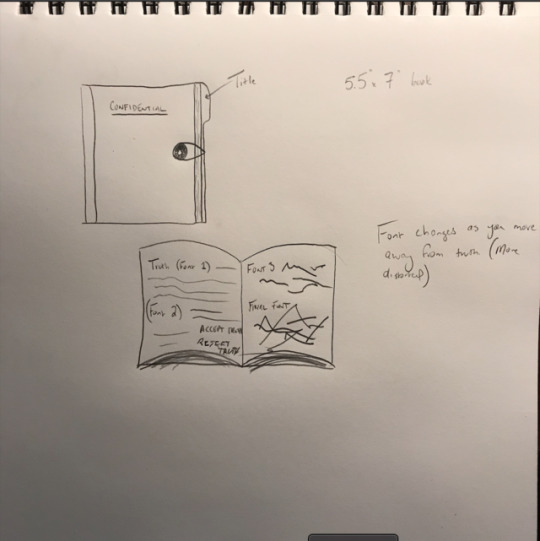Text
December 11, 2018
I also made a digital prototype of “What Really Happened?” for presentation purposes. Not all of the options are clickable – doing so would have meant recreating the whole book digitally – but you can get a sense of how the book flows.
Figma Prototype: “What Really Happened?”
0 notes
Text
December 11, 2018
Final Project: “What Really Happened?”
My final project is a choose your own adventure book called “What Really Happened?: JFK, Oswald, and the Quest for Truth.” (The title is a reference to former Soviet Union leader Nikita Khrushchev who, when he was informed that JFK was assassinated by a lone gunman, replied “What really happened?” The purpose of this book is to force readers to pay closer attention not only to the information they’re consuming, but also how that consumption can alter their perception of the world and of objective reality itself.
The digital age encourages us to take shortcuts: use Google Maps instead of learning how to read an actual map; connect with people you’ll never actually meet; have a conversation with someone without actually having to talk to them (or use real words). In fact, the internet itself is a shortcut. It starts out as a way to get what you need more quickly, and then it becomes a way to get what you want more quickly. Eventually, you run out of things to want or need, so it becomes a way to get more quickly; thus begins the cycle of endless consumption.
“What Really Happened?” is an attempt to restore some measure of intentionality or thought to the process of consuming information. Rather than the simple gratification of tapping or clicking to see what the next page looks like, readers must first consider their options and the path they’re on before deciding which page to turn to next.

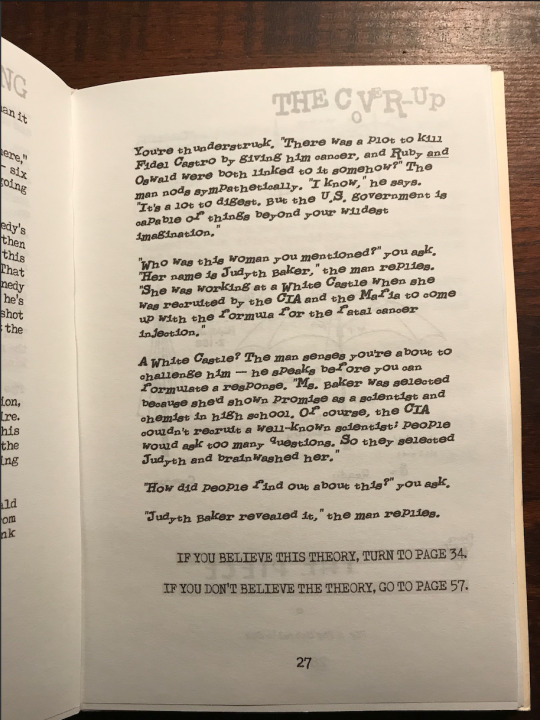
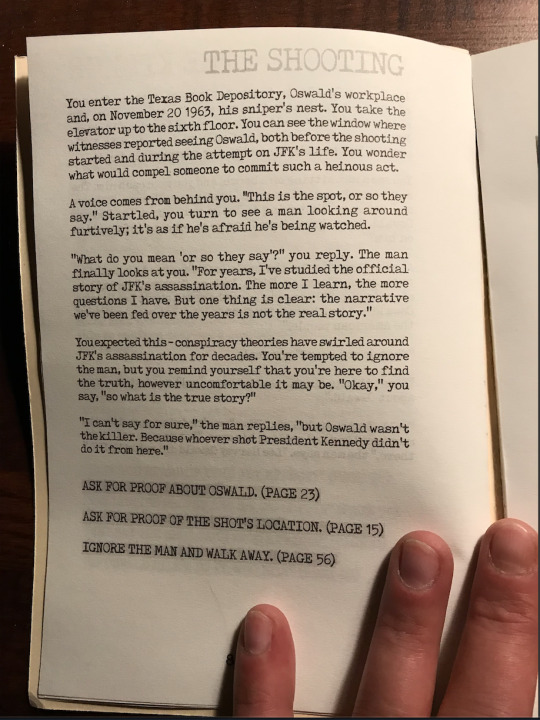
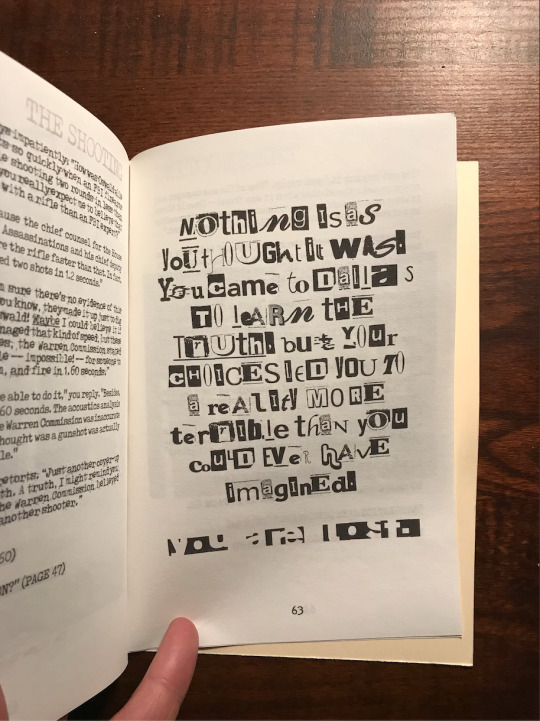

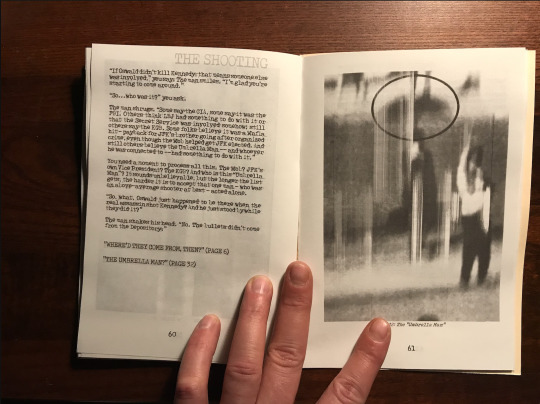
0 notes
Text
November 13, 2018
My Ideas:
I initially thought the “Encyclopedia Impulsiva” was my strongest idea, but after presenting my ideas to the class, I decided to go with the Choose Your Own Adventure book about the JFK assassination.
The more I thought about it, the more I realized that the encyclopedia idea was an interesting notion, but would become somewhat repetitive and not challenging in practice. More importantly, it didn’t really get to the heart of the question I want to answer – “How might we rethink the way we consume information?” The CYOA book, on the other hand, offers both a unique challenge and an opportunity for me to really explore the slippery slope that our desire for new information 24/7 can put us on. (Plus, people seemed to like that idea a lot, probably because CYOA books have a certain nostalgia to them.)
The Serving Library & Troll Thread:
These two publishers are similar in that they both aggregate existing material that has been published elsewhere. By the same token, their approach to publishing is much more democratic and open – they’re much more concerned with turning their audience on to existing work, rather than “breaking” new writers.
The main difference I see is that The Serving Library seems to be more structured/considered in terms of content: what they publish is based on a specific theme. Troll Thread, on the other hand, doesn’t care as much about cohesiveness or order. They also seem to make publishing decisions based on what they like, not based on what they think their audience demands.
P–DPA:
I really like the “Burned Books” project, likely because it complements my own feelings on the ubiquity of the internet. It (properly, in my view) depicts the internet as an all-consuming beast that swallows up everything in its way, stamping over once-valuable pieces of publishing (like the Yellow Pages) with the word “GOOGLE,” or full pages of the dictionary with “OMG LOL.” It makes its point without being too on-the-nose, which is what I’m aiming for with my final project.
0 notes
Link
This presentation is the starting point for my final project. It’s based on the question of how we can (or should) rethink the manner in which we receive information.
The advent of the internet has given us increased access to almost limitless amounts of information. But that increased access has also changed our relationship with information: rather than seeking out the specific knowledge we’re looking for, we now just consume whatever information is in front of us. And in our rush to gobble up new information at all times, we’ve stopped thinking about what each piece means and how it impacts the way we view the world. Each of these ideas is intended to make the audience slow down and reconsider their relationship with new information.
0 notes
Link
0 notes
Quote
[W]ith iOS 9 and content blockers, what you're seeing is Apple's attempt to fully drive the knife into Google's revenue platform. iOS 9 includes a refined search that auto-suggests content and that can search inside apps, pulling content away from Google and users away from the web, it allows users to block ads, and it offers publishers salvation in the form of Apple News, inside of which Apple will happily display (unblockable!) ads, and even sell them on publishers' behalf for just a 30 percent cut.
Oh, and if you're not happy with Apple News, you can always turn to Facebook's Instant Articles, which will also track the shit out of you and serve unblockable ads inside of the Facebook app, but from Apple's perspective it's a win as long as the money's not going to Google.
Nilay Patel, “Welcome to hell: Apple vs. Google vs. Facebook and the slow death of the web”
On some level, I have always viewed ads, tracking and data mining as an unavoidable consequence of using the internet, and as a result, I’ve never trusted tech companies. In fact, I tend to view my web use as a game and tech giants as my opponents: their goal is to collect and monetize as much of my personal information as possible, and my objective is to use the internet in such a way that I only give them information I don’t care about keeping private.
So while Patel’s piece isn’t necessarily surprising to me, it does paint a clearer picture of just how formidable an opponent I’m up against. As more and more people come to the realization that tech companies are not saviors, tech companies have tightened the net around Internet users by reshaping the internet in such a way that unless users take significant countermeasures to protect their data, at least one of the tech giants will be able to access it. And I have a feeling it’s only going to get worse.
0 notes
Quote
[The Apple/iTunes model has] introduc[ed] a new paradigm of selling tracks instead of albums, and thus atomising content instead of gathering it into a greater whole...atomising [newspaper or magazine] content...introduces the risk of an entirely populist editing process.
Ludovico, p. 60
Ludovico talks a lot about the “atomising” of content, but I don’t agree with his premise that this process is a byproduct of the digital age. Before Apple and iTunes sold individual songs, record stores sold singles; likewise, the publication of Sports Illustrated didn’t cause newspapers to shutter their sports sections. What Ludovico is describing is not caused by populism, but by capitalism.
Apple and iTunes don’t sell individual songs because the people demand specific songs; they sell individual songs because it’s a way to make some money off of consumers who would otherwise not bother to purchase a full album. In my view, publishers don’t atomize their content because of public opinion, but because selling each section as a self-contained unit allows them to generate revenue from people who might only want to read about, say, fashion, and don’t want to purchase a full newspaper in order to do it.
0 notes
Text
Does Presentation Matter?
In theory, the manner in which content is presented to us shouldn’t affect how we consume it: no matter how a sentence is presented to us, it should mean the same thing, imply the same thing, be received in the same way. But in practice, this is rarely – if ever – the case.
Take the Kindle, for example. E-readers offer exponentially greater options in terms of how a book can be presented, yet despite that increased flexibility, they are designed to mimic as closely as possible the experience of reading a paper book: page-turning animations and sound effects; cream-colored backgrounds; more “traditional” typefaces. Why? Because reading a book carries with it certain expectations; namely, that the reader has time to read it and fully digest the information contained therein. As a corollary, books are written according to the same assumption: authors don’t feel pressured to keep the audience’s attention at every turn. Their audience has more patience.
If you’re visiting a website, you’re accustomed to the information being packaged in clear, easy-to-read chunks that draw the eye and let you know (however subtly) what you need to focus on. In other words, you can allow your attention to wander a bit. But if a novel is presented in a web format, readability suffers: the visual cues no longer exist, and the audience – expecting to quickly and painlessly consume the information – will quickly become confused and lose interest.
Even though presentation shouldn’t matter, it does.
0 notes
Link
0 notes
Text
What Does “Content” Mean?
Over the past decade, the term “content” has evolved – and not for the better. For starters, in the earlier days of the internet, the term “content” wasn’t nearly as prevalent as it is now. Articles were articles; videos were videos; art was art. Websites existed out of necessity: these elements needed a place to live on the internet. But it was always assumed that people visited websites because of what was on them.
Over time, however, the balance of power shifted. Now, the focus is on the site itself, and what’s on the page is a secondary (or even tertiary) concern. “Content” may as well mean “wallpaper”; it’s something for people to look at while they’re visiting a site, but if they don’t, that’s okay too, because they’re on the site, and that’s what’s most important. Most sites don’t care if their readers are intellectually stimulated, so they don’t care what the content itself is, as long as it’s there. It’s a nearly-inexhaustible resource, a means to keep visitors entertained so advertisers have more opportunities to sell them things they don’t need.
And as users, we’ve come to accept the bare minimum. We go to our favorite sites and consume content mindlessly until we find something that satisfies us; once we’ve gotten our reward, we move to another site and repeat the cycle.
0 notes
Text
Response: Detail in Typography
Because I don’t have a background in design, my view of typography as an art form was fairly limited. I operated under the impression that typography was primarily focused on looks; if a font looks interesting or unique, it doesn’t really matter how readable it is as long as it’s readable. The Hochuli book, of course, demonstrates that there’s a lot more to typography than I previously imagined.
It’s interesting to me that even though typography is an attempt to create a new form of expression, typographers never demand that the audience adjust the way they read to meet a font. In that sense, typography is unique: it’s subversive, yet always somewhat restricted by a rigid set of best practices. This balancing act makes it all the more impressive that new fonts can still be created.
0 notes
Link
0 notes
Quote
The latest influence campaigns also imitated posts by legitimate pages and groups on Facebook that advocate political beliefs, making it difficult to tell what was a genuine post and what was not. Let’s compare some to see if you can tell the difference. Spoiler: It isn’t easy.
NYT, “Can You Spot the Deceptive Facebook Post?”
I don’t know if it’s because I happen to have a very finely-tuned bullshit detector or if it’s because I spend too much free time online, but I didn’t really find it difficult to spot the fake posts. I have a general rule of thumb when it comes to measuring the validity of social media posts: the more surprised I am by a post, the less likely it is to be true. (A corollary to this is the more inflammatory the headline, the further it is from the actual story.)
More than anything else, misleading or fake Facebook posts rely on an uninformed audience in order to take root. I read a lot of news and am a generally well-informed person, so if I see a headline that says “Nancy Pelosi Under Investigation for TREASON,” I know it’s bullshit; Nancy Pelosi is effectively Republican-lite and prizes bipartisanship (i.e., giving Republicans whatever they want) above all, and the GOP certainly isn’t going to slay a golden goose like that just because she’s vaguely critical of Trump.
It is alarming how many people will buy into a headline like that, but I’m also fascinated by why they do: it seems to be more and more common for people to assess the value of “news,” whether real or fake, according to how it makes them feel. In other words, Person A might believe the Nancy Pelosi thing because they’re uninformed, but Person B might believe it because they desperately want it to be true.
That, I think, is a large part of why misinformation can spread so far and so fast. These influence campaigns gain steam not just from people who don’t know any better, but from people who do know better and choose to engage in some strange wish fulfillment exercise. (There is also a not-insignificant bloc of trolls who knowingly perpetuate the spread of misinformation solely for a laugh; I wrote about a recent 4chan hoax on my blog.)
I didn’t see a way to upload my publication comparison as a PDF on here, and I didn’t want to do it as a series of images, so here’s a link to the PDF.
0 notes
Quote
...[T]he auteur theory...was a legitimizing strategy, a method to raise what was considered low entertainment to the plateau of fine art. By crowning the director the author of the film, critics could elevate certain subjects to the status of high art. That elevation, in turn, would grant the director new freedoms in future projects. [...]
[Like the film director], the designer works on a number of diverse projects over the course of a career, many of which have widely varying levels of creative potential; any inner meaning must come through the aesthetic treatment as much as from the content.
Michael Rock, “Designer As Author”
I tend to think of authorship as a zero-sum proposition. As such, while I understand the impetus behind elevating a director’s work for the sake of film’s legitimacy as an art form, in order to do so, the writer’s contribution to a film had to be diminished and/or de-emphasized – a practice that continues even now.
One of the first things a screenwriter learns is that visual elements, camera direction, etc. are considered solely the realm of the director. Adding in visual elements in a script – even if an entire scene hinges on a visual cue – is forbidden. One would think the writer’s vision would be given more consideration; after all, they are creating the film’s world and the people in it. Instead, the director’s vision supersedes that of the writer, even though the former only exists because of the latter.
As a writer, I’m probably biased, but in my view a director ought to be regarded in the same way we view print editors: their job is to wring the best out of what’s on the page. Authorship in this instance should be credited to the person who conceptualized the idea and put pen to paper, not to the person who took an existing idea and put a little polish on it.
That said, I do recognize that this definition of authorship would put designers – or at least those who design film posters – squarely at the bottom of the pecking order, which is perhaps unfair. Then again, designers are free to create works drawn from personal inspiration, just as directors are free to write screenplays based on their own ideas. Ultimately, I believe authorship belongs to the individual who had an idea and saw it through.
0 notes
